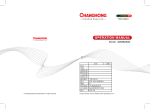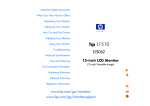Download HP Pavilion a434 Specifications
Transcript
Important Safety Instructions What Your New Monitor Offers Unpacking Your Monitor Setting Up Your Monitor Adjusting Your Monitor Using Your Monitor Troubleshooting Technical Specifications hp pavilion fx50 P3901 15-inch lcd monitor (15-inch Viewable image) Care and Cleaning Environmental Information Regulatory Information X English How To Install The Drivers hp pavilion fx50 15” lcd monitor English Notice The information contained in the documents accompanying this product is subject to change without notice. Hewlett-Packard makes no warranty of any kind with regard to this material, including, but not limited to, the implied warranties of merchantability and fitness for a particular purpose. Hewlett-Packard shall not be liable for errors contained herein or for incidental or consequential damages in connection with the furnishing, performance, or use of this material. Hewlett-Packard assumes no responsibility for the use or reliability of its software on equipment that is not furnished by Hewlett-Packard. These documents contain proprietary information that is protected by copyright. All rights are reserved. No part of these documents may be photocopied, reproduced, or translated to another language without the prior written consent of Hewlett-Packard Company. Hewlett-Packard Company Home Products Division P.O. Box 4010 Cupertino, CA 95015-4010 USA © Copyright Hewlett-Packard Company, 2001. All rights reserved. Hewlett-Packard is a registered trademark of Hewlett-Packard Company in the United States of America and other countries. Other brand or product names are trademarks of their respective holders. 2EnglishEnglish X slim and space saving full scan TFT screen that gives an edge to edge image anti-glare surface on/off Switch volume control sub-menu selection & adjustment buttons power status indicator auto adjustment button menu button hp pavilion fx50 P3901 15-inch lcd monitor (15-inch Viewable Image) User’s Guide X English 16.7 million colors for vivid image hp pavilion fx50 15” lcd monitor Imp o rta nt S a fet y Ins tru c t io ns Important Safety Instructions WARNING For your safety always connect equipment to a grounded wall outlet. Always use a power cord with a properly grounded plug, such as the one provided with the equipment, or one in compliance with your national safety standards. This equipment can be disconnected from the power by removing the power cord from the power outlet. This means the equipment must be located close to an easily accessible power outlet. English To avoid electrical shock, do not open the monitor's cover. There are no userserviceable parts inside. Only qualified service personnel should service these parts. Make sure your PC is powered off before connecting or disconnecting a display peripheral. Working Thank you for selecting HP monitor equipment. in Comfort To optimize your comfort and productivity, it's important that you set up your work area correctly and use your HP equipment properly. With that in mind, we have developed some setup and use recommendations for you to follow based on established ergonomic principles. You can consult the online version of Working in Comfort preloaded on the hard disk of HP computers, or visit HP's Working in Comfort web site at: http://www.hp.com/ergo/ CAUTION The lightning flash with arrowhead symbol, situated within an equilateral triangle, is intended to alert the user to the presence of uninsulated "dangerous voltage" which may be of sufficient magnitude to constitute a risk of electric shock. ! The exclamation mark within an equilateral triangle is intended to alert the user to the presence of important operating and servicing instructions in the literature accompanying the appliance. WARNING Before you connect any cables or install your HP monitor, refer to the above safety instructions. Refer also to the user’s manual that accompanies your PC and the video adapter to ensure this equipment is correctly installed. 2EnglishEnglish X hp pavilion fx50 15” lcd monitor Wha t Y o ur N ew M o nit o r Off ers What Your New Monitor Offers Your HP monitor is an LCD 15-inch, high resolution, multisynchronous color monitor. Multi-synchronous means that the monitor supports a range of video modes. It is optimized for use with all Hewlett-Packard computers. Your HP color monitor has the following features: A 15-inch Thin Film Transistor (TFT) liquid crystal display. • Support of video modes up to 1024 x 768 at a 75 Hz refresh rate. • Auto-configuration of display position, clock and phase. • Integrated 2 x 8W PMPO speaker plus microphone. 2 upstream (PC to monitor), 2 downstream (microphone and headphone connector) • An On-Screen Display (OSD) allows you to adjust all settings with on-screen menus. • A power management system (VESA1 standard) controlled from suitably equipped HP computers to automatically reduce the power consumption of the monitor. This system complies with the Energy Star Computers Program initiated by the US EPA2 specification for energy efficient monitors. As an Energy Star Partner, Hewlett-Packard has determined that this product meets the Energy Star guidelines for energy efficiency.3 • Plug and Play capability (compliant with VESA DDC1, DDC2B standards) that enables the monitor to identify itself to suitably equipped HP computers. • Your HP monitor complies with TCO 99 requirements. • Your monitor complies with MPRII guidelines for upper limits of electrical and electrostatic emissions, from the Swedish National Board of Measurement and Testing. • Slot for security lock. 1. 2. 3. VESA is the Video Electronics Standards Association. The US EPA is the United States Environmental Protection Agency. ENERGY STAR is a US registered service mark of the US EPA. X English3 English • hp pavilion fx50 15” lcd monitor Un pack ing Y o ur M o nit o r Unpacking Your Monitor English Check for the following items. If they are missing or damaged, consult your place of purchase immediately. • 1 LCD • 1 power cord and adapter • 2 audio cables • 1 video cable • 1 quick set-up card • 1 warranty booklet • 1 CD-ROM 4EnglishEnglish X hp pavilion fx50 15” lcd monitor S ett i ng Up Yo u r M o nit o r Setting Up Your Monitor Where to Place the Monitor Place your monitor on a flat sturdy surface. Ensure the operating site is free from excessive heat and moisture. WARNING Before you connect any cables, or install your HP monitor, refer to the safety Connecting the Cables This monitor is equipped with an auto-sensing power supply for voltage ranges 100 ~ 240V AC, 50 ~ 60 Hz. Only use with the supplied adapter. audio connectors video connector adapter output video cable power source power cord 1 Make sure the system power is turned off. 2 Plug the signal cable into the signal connector at the rear of the PC. 3 Plug the adapter output cable into the jack at the rear of the monitor and the power cord to the adapter. X English5 English instructions at the beginning of this manual. Refer also to the user’s manual that accompanies your PC and video adapter to ensure this equipment is correctly installed. English hp pavilion fx50 15” lcd monitor S et ting Up Y o u r M o nit o r 4 Plug the video cable into the video connector at the rear of the monitor. Secure the cable by tightening the thumb screws on the video connector. 5 Connect the audio cables to the connectors according to the following color definitions: Red + Green end ➔ PC Red + Blue end ➔ rear of LCD monitor 6 Connect the power cord to the power source. 7 Turn on the computer and the monitor. Connecting the Speakers Your monitor comes with built-in speakers. If you bought your monitor with a Hewlett-Packard™ Pavilion home PC, you will have two sets of speakers: an external set shipped with the PC, and the built-in monitor speakers. The PC's external speakers connect to a Speaker Out port identified on your PC's setting up poster, and will provide the best sound with most Pavilion PCs. If you want to use the monitor's built-in speakers, you must connect them to the Line Out port on the back of your PC. Use the two audio cables provided for connecting the speakers and the microphone to the PC; refer to Step 5 of “Connecting the Cables” on page 6. If your computer does not have a Line Out port, you can purchase a sound card with a Line Out port to use the internal monitor speakers. If you are not sure which port you have and your sound quality is poor, try connecting your external speakers to the Speaker Out port. 6EnglishEnglish X hp pavilion fx50 15” lcd monitor S ett i ng Up Yo u r M o nit o r Changing the Monitor Viewing Position English Your monitor can be rotated to either a landscape or portrait position. 1 Tilt the lower part of the monitor upwards. 2 Rotate the monitor clockwise until the monitor controls are on the left side. 3 Firmly push the lower part of the monitor downwards to secure it in the new position. To rotate your display, you need to install specific software. X English7 hp pavilion fx50 15” lcd monitor H o w T o In sta ll T he Dr iver s How To Install The Drivers In order to take advantage of the Plug & Play functionality of your Windows 95/98/2000 operating system, HP Monitors come with a driver. English To install this driver: Windows 1 Click on Start, select Settings, then click Control Panel. 2 Double click on Display. 95 and 3 Click on the Settings tab. 98 Users 4 Click on Advanced Properties or Advanced... and select the Monitor tab. 5 Click on Change... to select the model of the HP Monitor you are using. 6 Click on Have Disk... 7 Click on Browse... to find the P3901.INF file on your CD-ROM under the \Drivers directory and click on OK. 8 Select your monitor type from the Models box and click on OK to install the selected monitor. Windows 1 Click on Start, select Settings, then click Control Panel. 2 Double click on Display. 2000 Users only 3 Click on the Settings tab. 4 Click on Advanced Properties or Advanced... and select the Monitor tab. 5 Click on Properties. 6 Click on the Driver tab. 7 Click on Update Driver... and click on Next. 8 Select the Recommended option and click on Next. 9 Check the Specify a Location box. 10 Find and open the P3901.INF file on your CD-ROM under the \Drivers directory and click on OK. 11 Click on Next to install the selected monitor. Your operating system and your HP Monitor are now set up to work in optimum conditions. If the installation procedure of your monitor driver on your Windows 95/98/2000 version is different or you need more detailed installation information, please refer to Windows 95/98/2000 user's manual. 8EnglishEnglish X hp pavilion fx50 15” lcd monitor Ad just ing Yo ur Monit o r Adjusting Your Monitor A Look at the Control Panel ➁ ➂ ➃ ➄ There are 5 buttons which perform the following operations: ➀ Auto Adjustment button: automatically adjusts the main settings. ➁ Validation (Enter Sub-Menu) button: acts as an enter button, selects sub-menus. ➂ ➃ Volume Control/Select and Adjustment buttons: mute and unmute the speaker when pressed simultaneously. ➄ Menu button. When to Adjust the Monitor NOTE • When the monitor is installed for the first time • If the resolution or frequency has been changed • If the graphic card has been changed • If the monitor is connected to a different computer • After using the Recall function, (refer to “Miscellaneous” on page 17). It is recommended that you select a video mode of 1024 x 768 at 60Hz on your computer for optimum performance. X English9 English ➀ hp pavilion fx50 15” lcd monitor Ad just ing Y o ur Moni tor Automatic Setup English Using the Auto button and the test pattern on the CD-ROM provided, you can easily optimize your screen performance. 1 Insert the CD-ROM provided into the PC. Run the program D:\auto.exe to display a pattern used for setup. 2 Press the Auto button. Normally, this should produce a stable, centered image. Your optimizer utility also contains driver for Windows 95, Windows 98 or Windows 2000 D:\Drivers\P3901.INF. Manual Setup Follow these steps only if further adjustments are needed. For further information, refer to “Using Your Monitor” on page 11. 1 2 3 4 Display the pattern using the CD-ROM as described above. Press Enter to display the OSD menu. Select the Geometry icon. Select Pixel Clock and adjust the value to minimize vertical bars. 5 Select Phase and adjust the value to minimize horizontal bars. 6 Select Horizontal Position and Vertical Position to adjust screen position. 7 Press the Exit button to save the values. 10EnglishEnglish X hp pavilion fx50 15” lcd monitor Us ing Your M o nit o r Using Your Monitor Setting the Language The OSD menus can be displayed in several different languages. To change your language setting, refer to “Miscellaneous” on page 17. The Auto Button 1 Press the Auto button and the following on-screen menu is displayed: To 2 Press the Auto button again to activate the auto-adjustment feature. You are then prompted to save the auto settings by pressing the button. NOTE For best results, it is recommended to use the CD-ROM supplied with the monitor to display a pattern before using the Auto button. The On-Screen Display (OSD) Main Menu The Main Menu of the On-Screen Display (OSD) is divided into six groups of features (or sub-menus) for making adjustments . ➀ Luminance ➁ Geometry ➂ Auto Adjustment ➃ Color adjustment ➄ Audio ➅ Miscellaneous X English11 English The Auto button automatically adjusts V-Position, H-Position, Pixel Clock and Phase for an optimal image. hp pavilion fx50 15” lcd monitor Us ing Y o ur M o ni tor Each of these functions is described in turn in this section. ➀ ➁ ➂ ➃ ➄ ➅ English Making Adjustments 1 Press the Menu button to access the main OSD. 2 Use the or buttons to move through the sub-menus, and press to enter the sub-menu. 3 Use the or buttons to move through the various choices within the sub-menu, and validate your choice by pressing the button. 4 Press the or buttons to adjust the settings, then press the Menu button to exit the sub-menu. 5 Press the Menu button to exit the respective sub-menus, and press the Menu button to exit the OSD. NOTE Before exiting the OSD, you are prompted to save your settings. The Sub-Menus Luminance Contrast adjusts the difference between the light and dark areas. Brightness adjusts the brightness of the display. To make adjustments in the Luminance sub-menu: 12EnglishEnglish X hp pavilion fx50 15” lcd monitor Us ing Your M o nit o r Geometry Hor. (horizontal) Position: adjusts the horizontal position of the display. Ver. (vertical) Position: adjusts the vertical position of the display. Language Select: Deutsch, English, Español, Français, Italiano, Japanese. Phase: adjusts the phase of pixel clock. It can improve the focus of your screen as well. Pixel Clock: adjusts the frequency of the pixel. To make adjustments in the Geometry sub-menu: 1 Press the Menu button and use the or buttons to highlight the Geometry icon. 2 Press the button to select the feature. 3 Use the or buttons to choose one of the menu items listed above, then press the button to select it. 4 Press or buttons to adjust the settings (the settings are automatically saved). X English13 English 1 Press the Menu button and use the or buttons to highlight the Luminance icon. 2 Press the button to select the feature. 3 Use the or buttons to choose either Contrast or Brightness, then press to select it. 4 Press or buttons to adjust the settings (the settings are automatically saved). 5 Press the Menu button to exit the sub-menu, then press the Menu button to exit the respective sub-menus. 6 Press the Menu button to exit the OSD. hp pavilion fx50 15” lcd monitor Us ing Y o ur M o ni tor 5 Press the Menu button to exit the sub-menu, then press the Menu button to exit the respective sub-menus. 6 Press the Menu button to exit the OSD. Auto Adjustment The Auto button automatically adjusts V-Position, H-Position, Pixel Clock and Phase for an optimal image. English To use the Auto Adjustment sub-menu: 1 Press the Auto button and the following on-screen menu is displayed: 2 Press the Auto button again to activate the auto-adjustment feature. You are then prompted to save the auto settings by pressing the button. NOTE For optimum results, it is recommended that you display the pattern provided on the CD-ROM supplied with your monitor, before using the Auto button. Color Adjustment This function is defined as color temperature adjustment. There are three preset modes. The following is the value of each preset mode. Color mode Color Temperature (Preset Mode) C1 9300k C2 6500k C3 5800k To make adjustments in the Color Temperature sub-menu: 14EnglishEnglish X hp pavilion fx50 15” lcd monitor Us ing Your M o nit o r 1 Press the Menu button and use the or buttons to highlight the Color icon. 2 Use the or to choose one of the options listed above. 3 To validate your choice, use the Menu button to exit the submenus until you are prompted to save your changes. Press the button to select Yes. 4 To make changes in User Mode, use the or buttons to highlight the User Mode icon then press the button. English 5 Use the or buttons to choose R, G or B (Red, Green or Blue), then press the button to enter the chosen menu item. X English15 hp pavilion fx50 15” lcd monitor Us ing Y o ur M o ni tor English 6 Use the or buttons to make the required adjustments (the settings are automatically saved). Audio This feature allows you to adjust the volume and mute/unmute the speaker. To make adjustments in the Volume sub-menu: 1 Press the Menu button and then use the the Volume sub-menu, then press the or buttons to locate button. 2 Press the button to choose the required menu item. 3 Use the or buttons to adjust the setting (the settings are automatically saved). 4 Press the Menu button to exit the sub-menu, then press the Menu button to exit the respective sub-menus. 5 Press the Menu button to exit the OSD. 16EnglishEnglish X hp pavilion fx50 15” lcd monitor Us ing Your M o nit o r To mute/unmute the speaker you can adjust the settings in the submenu, using the or buttons. Use Menu to exit the OSD. English MUTE DISABLE You can press the buttons to simultaneously mute/unmute the speaker. Miscellaneous This functions contains the following menu items: Hor. (horizontal) Position: adjusts the horizontal position of the OSD. Ver. (vertical) Position: adjusts the vertical position of the OSD. Language Select: Deutsch, English, Español, Français, Italiano, Japanese. OSD Time: shows you how many seconds the OSD is displayed on-screen. X English17 hp pavilion fx50 15” lcd monitor Us ing Y o ur M o ni tor Information: displays current settings: Resolution, Horizontal and Vertical frequency. English To access the Recall function, first select Information, then select Recall from the sub-menu. Recall: If you press , factory preset settings will be recalled. The settings that are affected by the Recall function are RECALL EXIT • Screen Geometry • Horizontal Frequency • Vertical Frequency • Brightness / Contrast WARNING By pressing the button all previous adjustments are lost (refer to “Adjusting Your Monitor” on page 9 to adjust the monitor again). Setting the Amount of Displayed Information To set the amount of displayed information, change the screen resolution of your computer. The higher the screen resolution, the more information you can see on the screen. It is recommended that you use a resolution of 1024 x 768. It is recommended that you use a refresh rate of 60 Hz. The image refresh rate is the number of times per second that the image is redrawn. NOTE LCD technology does not cause any flicker at low refresh rates. Minimizing Energy Consumption If your computer supports VESA monitor power management (available on many HP computers), you can minimize the power consumed by the monitor. There are two power saving modes: • Suspend mode (uses less than 5W) • Sleep mode (uses less than 5W) 18EnglishEnglish X hp pavilion fx50 15” lcd monitor Us ing Your M o nit o r When the monitor enters power saving mode, the message No Signal is displayed for a few seconds before the screen blanks. In power saving mode the front panel indicator light is amber. To set these power saving modes, refer to the manual that came with your computer. Supported Video Modes NOTE Screen Resolution Image Refresh Rate 640 x 350 70Hz 640 x 480 60Hz, 75Hz 720 x 400 70Hz 800 x 600 60Hz, 75Hz 1024 x 768 60Hz, 75Hz Selecting a combination of screen resolution/image refresh rate higher than 1024 x 768 at 75Hz will effect display performance. If you select a video mode not supported by your monitor, the following message will be displayed: X English19 English Your monitor comes with the standard modes shown in the table below. It also supports intermediate video modes. With the intermediate modes, the displayed image may need to be optimized using the buttons on the front panel. All modes are non-interlaced. hp pavilion fx50 15” lcd monitor Tr ouble sh ootin g Troubleshooting Before calling HP check the following: English There is no picture and LED is off: • Check that the monitor is switched on. • Check that the power cord is properly connected. • Check the electrical outlet. • Test and see if monitor works on another PC previously set to another monitor’s supported resolution. There is no picture and the LED is on: • Check that the monitor is not in power saving mode. • Adjust the Contrast and Brightness through OSD or control buttons. • Check that the PC is switched on. • Check that the video cable has no bent pins. • Test that the monitor works on another PC previously set to another monitor’s supported resolution. The picture is fuzzy: • Adjust your monitor, using the Automatic Adjustment function (refer to “Auto Adjustment” on page 14). • If you are running a Windows 95/98/2000 Operating System then install the INF file - Plug and Play driver (refer to “How To Install The Drivers” on page 8). • Change the resolution to the recommended resolution 1024 x 768 at 60Hz. Pixels are missing: • Refer to “LCD Monitor Quality and Pixel Policy” on page 21. Colors are not pure: • Check that the video cable has no bent pins and is firmly attached to both the PC and monitor Video Connectors. • Recall the colors default factory settings (refer to “Miscellaneous” on page 17). • Adjust the RGB (Red, Green and Blue) colors to as required (refer to “Color Adjustment” on page 14). 20EnglishEnglish X hp pavilion fx50 15” lcd monitor T ro u b les ho o ting The picture is not centered: • Adjust your monitor using the Automatic Adjustment function (refer to “Auto Adjustment” on page 14). A pixel consists of one red, one green and one blue sub-pixel. Defective sub-pixels are less visible than defective whole pixels. Defective sub-pixels are small and only visible on a specific background. Defective means either the pixel or sub-pixel is stuck always ON, a bright spot on a dark background, or it is stuck always OFF, a dark spot on a bright background. The first is the more visible of the two. A dot defect is a stuck sub-pixel. Your HP P3901 will not have more than: • 10 total dot defects • 8 stuck full pixels • 8 stuck red sub-pixels • 5 stuck green sub-pixels (green is most visible) • 8 stuck blue sub-pixels • No more than two adjacent pixels may be stuck Adjacent is defined as less than 15mm edge to edge • No more than two pairs of two-adjacent stuck pixels per display To locate defective pixels, the unit should be viewed under normal operating conditions and in normal operating mode at a supported resolution and refresh rate, from a distance of approximately 50 cm (16 in.). HP expects that over time, the industry will continue to improve its ability to produce displays with fewer cosmetic imperfections and HP will adjust our guidelines as improvements are made. X English21 English LCD Monitor Quality and Pixel Policy Your Hewlett-Packard TFT display uses high precision technology, manufactured according to HP standards, to guarantee trouble-free personal computing. Nevertheless, your display may have cosmetic imperfections that appear as small bright or dark spots. This is common to all LCD displays used in products supplied by all vendors and is not specific to the HP P3901 displays. These imperfections are caused by one or more defective pixels or sub-pixels. hp pavilion fx50 15” lcd monitor Te chni cal Sp ecifi ca tion s Technical Specifications Type Video 15 inch diagonal and viewable image TFT liquid crystal display 0.7 Vp-p analog RGB Synchronization Separated H/V (TTL level) INTERFACE Input Connector 15-pin D-SUB SCANNING FREQUENCY Horizontal Vertical 1024 x 768 (75 Hz) 31–60 kHz 56–75 Hz LIQUID CRYSTAL MONITOR English INPUT SIGNAL MAX. RESOLUTION (H x V) RECOMMENDED RESOLUTION (H x V) POWER SOURCE OPERATING ENVIRONMENT STORAGE ENVIRONMENT DIMENSIONS WEIGHT TILT STAND Size 1024 x 768 (60Hz) AC/DC ADAPTER Temperature Input Rating: 100–240v, 1.5 Output: 12V, 3A Frequency: 50/60 Hz Power Consumption: less than 36W in operating mode 15°C to 40°C Humidity 10% RH through 80% RH (without condensation) Temperature –20 ° C to 60 ° C Humidity 10% RH through 85% RH (without condensation) 379.6 (H) 417.4 (W) 205 (D) mm 6 Kg Tilt Angle 22EnglishEnglish –5° to 25° X hp pavilion fx50 15” lcd monitor Car e a nd Cl ea ning Care and Cleaning To maximize the screen life-span of this product and prevent damage to the liquid crystal display, it is recommended that you: Do not let liquid get on or into the monitor. • Do not store or use the monitor in locations exposed to heat, direct sunlight, or extreme cold. • Do not store or use the monitor in locations exposed to high humidity or in a dusty environment. • Do not press sharp or pointed objects against the monitor. • Avoid touching or pressing the screen of the monitor. • Avoid setting contrast and brightness to their maximum levels for prolonged periods. • Switch the monitor off when it is not in use. Your monitor is anti-glare. To prevent damage to the monitor screen's coating, use a regular household glass cleaner when cleaning the screen. To clean the screen: 1 Switch the monitor off and remove the power plug (pull the plug, not the cable). 2 Soak a soft gauze cloth with isopropyl alcohol or ethyl alcohol and gently wipe the surface of the monitor. Avoid dusting it or wiping it with a cloth dampened with water. 3 Dry with a clean, soft cotton cloth. Do not use cleaning solutions containing fluoride, acids, or alkalis. Do not use ketone substances such as acetone or solvents such as xylene or toluene to clean the monitor. Do not use benzene, thinner, ammonia, or any volatile substance to clean the monitor's screen or cabinet. These chemicals may damage the monitor. Never use water to clean a LCD screen. X English23 English • hp pavilion fx50 15” lcd monitor E nviron me nta l Inf o rma tion Environmental Information HP has a strong commitment toward the environment. Your HP monitor has been designed to respect the environment as much as possible. English HP can also take back your old monitor for recycling when it reaches the end of its useful life. HP has a product take-back program in several countries. The collected equipment is sent to one of HP's recycling facilities in Europe or the USA. As many parts as possible are reused. The remainder is recycled. Special care is taken for batteries and other potentially toxic substances, which are reduced to non-harmful components through a special chemical process. If you require more details about HP's product take-back program, contact your dealer or your nearest HP Sales Office. 24EnglishEnglish X hp pavilion fx50 15” lcd monitor R e gula tory In form ati o n Regulatory Information English X English25 hp pavilion fx50 15” lcd monitor Re g ul ato ry Infor mat ion Notice for the USA: FCC Class B Statement English Federal Communications Commission Radio Frequency Interference Statement Warning: This equipment has been tested and found to comply with the limits for a Class B digital device, pursuant to Part 15 of the FCC Rules. These limits are designed to provide reasonable protection against harmful interference in a residential installation. This equipment generates, uses, and can radiate radio frequency energy and, if not installed and used in accordance with the instructions, may cause harmful interference to radio communications. However, there is no guarantee that interference will not occur in a particular installation. If this equipment does cause harmful interference to radio or television reception, which can be determined by turning the equipment off and on, the user is encouraged to correct the interference by one or more of the following measures: • • • Reorient or relocate the receiving antenna. Increase the distance between the equipment and the receiver. Connect the equipment to an outlet on a different circuit to the one the receiver is connected to. • Consult your dealer or an experienced radio/TV technician for help. Hewlett-Packard's FCC Compliance Tests were conducted using HP-supported peripheral devices and HP shielded cables, such as those you receive with your system. Changes or modifications not expressly approved by Hewlett-Packard could void the user's authority to operate the equipment. This device complies with part 15 of the FCC Rules. Operation is subject to the following two conditions: (1) This device may not cause harmful interference, and (2) this device must accept any interference received, including interference that may cause undesired operation. Safety Warning for USA If the power cord is not supplied with your monitor, select the proper power cord according to your national electric specifications. • USA: use a UL listed type SVT detachable power cord Notice for Canada This Class "B" digital apparatus complies with all requirements of the Canadian InterferenceCausing Equipment Regulations (ICES.003). Cet appareil numérique de la Classe B est conforme à la norme MB-003 du Canada. X-Ray Radiation Notice If you must replace the cathode ray tube, replace it only with a CRT. 26EnglishEnglish X hp pavilion fx50 15” lcd monitor R e gula tory In form ati o n Notice for Korea Notice for Germany (Deutschland) LpA < 70db am Arbeitsplatz normaler Betrieb nach EN27779: 11.92 Notice for Japan (Class B) TCO 99 Congratulations! You have just purchased a TCO'99 approved and labelled product! Your choice has provided you with a product developed for professional use. Your purchase has also contributed to reducing the burden on the environment and also to the further development of environmentally adapted electronics products. Why do we have environmentally labelled computers? In many countries, environmental labelling has become an established method for encouraging the adaptation of goods and services to the environment. The main problem, as far as computers and other electronics equipment are concerned, is that environmentally harmful substances are used both in the products and during their manufacture. Since it is not so far possible to satisfactorily recycle the majority of electronics equipment, most of these potentially damaging substances sooner or later enter nature. X English27 English Hinweis für Deutschland: Geräuschemission Lärmangabe nach Maschinenlärmverordnung - 3 GSGV hp pavilion fx50 15” lcd monitor Re g ul ato ry Infor mat ion There are also other characteristics of a computer, such as energy consumption levels, that are important from the viewpoints of both the work (internal) and natural (external) environments. Since all methods of electricity generation have a negative effect on the environment (e.g. acidic and climate-influencing emissions, radioactive waste), it is vital to save energy. Electronics equipment in offices is often left running continuously and thereby consumes a lot of energy. What does labelling involve? English This product meets the requirements for the TCO'99 scheme which provides for international and environmental labelling of personal computers. The labelling scheme was developed as a joint effort by the TCO (The Swedish Confederation of Professional Employees), Svenska Naturskyddsforeningen (The Swedish Society for Nature Conservation) and Statens Energimyndighet (The Swedish National Energy Administration). Approval requirements cover a wide range of issues: environment, ergonomics, usability, emission of electric and magnetic fields, energy consumption and electrical and fire safety. The environmental demands impose restrictions on the presence and use of heavy metals, brominated and chlorinated flame retardants, CFCs (freons) and chlorinated solvents, among other things. The product must be prepared for recycling and the manufacturer is obliged to have an environmental policy which must be adhered to in each country where the company implements its operational policy. The energy requirements include a demand that the computer and/or display, after a certain period of inactivity, shall reduce its power consumption to a lower level in one or more stages. The length of time to reactivate the computer shall be reasonable for the user. Labelled products must meet strict environmental demands, for example, in respect of the reduction of electric and magnetic fields, physical and visual ergonomics and good usability. Below you will find a brief summary of the environmental requirements met by this product. The complete environmental criteria document may be ordered from: TCO Development SE-114 94 Stockholm, Sweden Fax: +46 8 782 92 07 Email (Internet): [email protected] Current information regarding TCO'99 approved and labelled products may also be obtained via the Internet, using the address: http://www.tco-info.com/ Environmental requirements Flame retardants Flame retardants are present in printed circuit boards, cables, wires, casings and housings. Their purpose is to prevent, or at least to delay the spread of fire. Up to 30% of the plastic in a computer casing can consist of flame retardant substances. Most flame retardants contain bromine or chloride, and those flame retardants are chemically related to another group of environmental toxins, PCBs. Both the flame retardants containing bromine or chloride and the PCBs are suspected of giving rise to severe health effects, including reproductive damage in fish-eating birds and mammals, due to the bio-accumulative1 processes. Flame retardants have been found in human blood and researchers fear that disturbances in foetus development may occur. The relevant TCO'99 demand requires that plastic components weighing more than 25 grams must not contain flame retardants with organically bound bromine or chlorine. Flame retardants are allowed in the printed circuit boards since no substitutes are available. Cadmium2 1. Bio-accumulative is defined as substances which accumulate within living organisms 28EnglishEnglish X hp pavilion fx50 15” lcd monitor R e gula tory In form ati o n Cadmium is present in rechargeable batteries and in the color-generating layers of certain computer displays. Cadmium damages the nervous system and is toxic in high doses. The relevant TCO'99 requirement states that batteries, the color-generating layers of display screens and the electrical or electronics components must not contain any cadmium. Mercury2 Mercury is sometimes found in batteries, relays and switches. It damages the nervous system and is toxic in high doses. The relevant TCO'99 requirement states that batteries may not contain any mercury. It also demands that mercury is not present in any of the electrical or electronics components associated with the labelled unit. CFCs (freons) Lead2 Lead can be found in picture tubes, display screens, solders and capacitors. Lead damages the nervous system and in higher doses, causes lead poisoning. The relevant TCO'99 requirement permits the inclusion of lead since no replacement has yet been developed. 2. Lead, Cadmium and Mercury are heavy metals which are Bio-accumulative. X English29 English The relevant TCO'99 requirement states that neither CFCs nor HCFCs may be used during the manufacture and assembly of the product. CFCs (freons) are sometimes used for washing printed circuit boards. CFCs break down ozone and thereby damage the ozone layer in the stratosphere, causing increased reception on earth of ultraviolet light with e.g. increased risks of skin cancer (malignant melanoma) as a consequence.








































